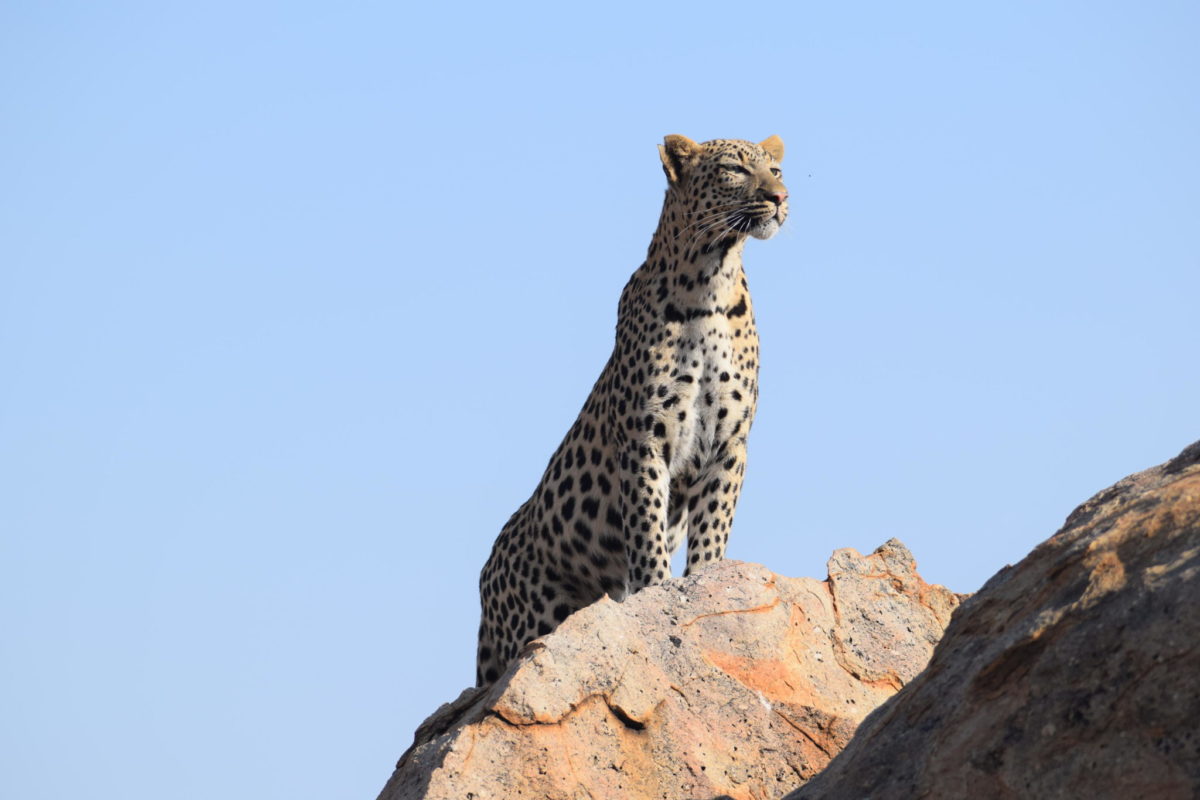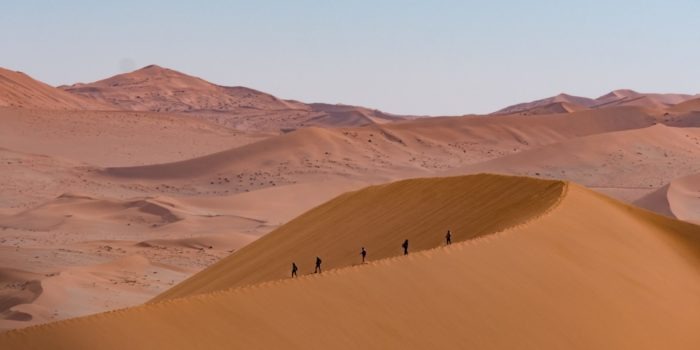Why we like it
- It’s not as easily accessible as the south, so is far less occupied by tourists.
- The mountainous scenery is a geologically phenomenal.
- Home of the desert lions, which have made a comeback from near extinction.
- Africa’s hub of rock paintings and engravings.
- Lots of epic outdoor activities like walking trails, 4×4 excursions, hiking, and scenic flights over the Skeleton Coast.
This is Namibia’s stone desert, hugged by the Skeleton Coast in the west and neighboured by Etosha National Park in the east. Home to the world’s only desert lions, critically endangered black rhino, and multi-millennia-old rock art. Welcome to the wild (north)west of Namibia!
Damaraland is located in the north-western region of Namibia and has some of the harshest landscapes in the country. Yet is sustains good populations of rare desert-adapted elephant, rhino, giraffe and lion, and promises to floor you with dramatic scenery. Here lives Namibia’s tallest mountain, its most volatile coastline, and rock formations that still impress 120-million years later.

A couple of hours north of Swakopmund, and about five hours north of Windhoek, you enter the region of Damaraland, named after the Damara people who originate in this harsh desert landscape. It’s a vast expanse with skittish wildlife and oppressive heat. It doesn’t sound like much, until you see it for yourself. Damaraland offers a sense of wilderness you’re unlikely to find elsewhere. It might resemble the moon, but the evidence of people having lived in these harsh conditions can be found all over the mountain caves that are scattered across the landscape.
Brandberg
Brandberg – or “burning mountain” in English – is Namibia’s most impressive mountain. A huge granite massif protruding from the flat desert floor stands at over 2.5km at its highest point, and it offers a challenging hiking experience to keen boulder scramblers.
The name Brandberg comes from the spectacular sight of the sunset igniting the mountain, but those who have embarked on the three-day hike to the Königstein summit say it could just as easily have come from the searing heat experienced during the climb! Not for sissies, as they say. This very rewarding excursion is a guided, carry-all hike with two overnight stops sleeping under the stars.
But the Brandberg is not just a hiker’s destination. It is a spiritual heartland in Namibia, full of ancient history and cultural significance. There are in the region of 40 000 individual San rock art paintings scattered over 900 different sites, making it one of the most decorated places on the continent for viewing pristine paintings and engravings. One of the most famous is called the White Lady – it impresses many people, while others find it no more spectacular than the art around it.
Spitzkoppe
A 1.5-hour drive south of Uis, which is home base for Mission: Brandberg, is perhaps Namibia’s most photographed geological wonder, Spitzkoppe. Part of a mountainous range called the Pontoks, you’re likely to glimpse these mounds of smooth, weathered granite boulders from the road, but they are definitely worth investigating up close, especially if you’re a mountaineer.
Spitzkoppe has the highest peak in the Pontoks, reaching over 1700 metres. These formations are around 130 million years old, formed when Gondwanaland split, and the fact that we can still scale their smooth surfaces today is a wonder of the world. Humans that came long before us left their mark in the form of rock art, of which there are a number of examples preserved today. The site “Bushman’s Paradise” is not worth visiting anymore after years of unfortunate vandalisation, but you can hike to see other well-worth-it sites.
Rock climbers will love this location. Spitzkoppe has over 100 set routes to choose from, varying in levels of difficulty. Single pitches, multi pitches and a big wall climb are all in place with anchors set for abseiling. The “rhino horn” is one of the most challenging and awe-inspiring climbs. Views are to die for and the golden hours at the start and end of each day make them unforgettable.
Non climbers will not miss out. There are a number of incredible rock arches, rock paintings, and undemanding hiking routes around Spitzkoppe that will suit everyone.
Twyfelfontein
Twyfelfontein is the hub of ethnic rock art in, some would say, Africa, let alone Namibia. It is a UNESCO World Heritage Site and a testament to the human history of hunter-gatherers and San in the area. The art you’ll see here, rather than at Brandberg and Spitzkoppe, is primarily petroglyphs or engravings, rather than paintings. The oldest date back 6 000 years and are the work of the early hunter-gatherers, and the newer paintings date back about 2 500 years to the time of the San.
The geology of the area is also very significant. The engravings are etched into sandstone slabs which have fallen into the valley from the surrounding flat-topped mountains. There are over 200 slabs with thousands of different paintings and petroglyphs depicting human hunters, cattle, rhino, zebra, lion, and other common wildlife species. You can hike to different sites to see a bunch of the most famous pieces with a guide to interpret what it is you’re seeing.
Within short driving distances are the sites of the Organ Pipes and Vingerklip – both unique rock formations that have been showing off on the landscape for millions of years. The Organ Pipes are basalt columns protruding from the ground in what can only be described as the shape of church organs. Vingerklip is a 35m-high single sandstone protrusion in the flat Ugab Valley.
Spending perhaps two nights at Twyfelfontein is well worth it to give yourself time to admire the landscape of the table-like Ugab Terraces and take a look at the different attractions. The petrified forest and the Damara Living Museum are other places of interest, and just to make sure you sleep in total comfort and style, Mowani Mountain Camp is the place to be.
Palmwag
Palmwag is the gateway to desert lion country. It’s where Damaraland truly becomes the stone desert and it’s the last very essential petrol station you’ll come across for a while! From Palmwag, turn westwards to the Skeleton Coast, eastwards to Grootberg and beyond that, Etosha, while heading north will take you to the Kunene River.
The Palmwag Concession is another of Namibia’s conservation successes – the result of a collaboration between private conservancies, the government, and Save the Rhino Trust. It safeguards the largest number of free-roaming black rhino in the world, and this is where you can track these creatures on foot.
While there are numbers of Hartmann’s mountain zebra, oryx, springbok, and kudu, plus the elusive but existent desert lions, as well as leopard, cheetah and hyena, this isn’t an ordinary safari destination with plenty of game viewing. The animals are skittish and disperse quickly from approaching vehicles. Being on foot is probably the best way to really make the most of a place as wild and wonderful as this – we can highly recommend the Etendeka Overnight Walking Trail for star-studded views at night and explorative on-foot excursions during the day.
Skeleton Coast
The Skeleton Coast is in Namibia’s “top three” next to Sossusvlei and Etosha National Park. While the other two are easily accessible and popularly visited, the Skeleton Coast is remote and rather hostile, as its name suggests! The stretch of uninhabited coastline is characterised by rusty old shipwrecks, dense mist, relentlessly rolling waves and a few seal colonies, which are at times the target of beach-roaming lions. Sound otherworldly? It is.
Despite this rough reputation, the Skeleton Coast offers some good fishing opportunities to keen anglers at Terrace Bay. Quad biking is one way to experience the dunes and build some adrenalin while the roar of the sea rings in your ears. Taking a scenic flight overhead will give you a bird’s eye view of the tossing sea, sculpted dunes, and eroding shipwrecks. It’s quite something to imagine the same view greeting rescue pilots during World War II as they arrived to deliver rations to stranded passengers on board wrecked ships. We love Shipwreck Lodge, which will give you guided access and inside intel on some of the famous wrecks on the beach.
This might be a seaside location, but in Namibia, even the elephants and lions have made their way to the coast. Often for predators, seals can be easy targets. Prey is scarce in the desert and slow, blubbery seals can be tempting enough to venture right up to the sea.
Rivers of Damaraland
The dry riverbeds that worm their way through Damaraland are all destined for the sea, but just like further south near Sossusvlei, the desert dunes hindered their progress and mostly swallowed them up. Now these riverbeds have become a critical part of the landscape in Namibia’s northwest. Their underground water feeds some resilient plants and trees that sustain the desert’s wildlife, and their wind- and water-eroded banks have become geomorphological marvels of the region.
The Hoarusib and Hoanib rivers are two of Damaraland’s ephemeral rivers and they are begging to be explored by 4×4 enthusiasts and campers. Not to worry, lodge-lovers, these remote and breath-takingly beautiful valleys have a few more-than-comfortable accommodation options in place! The wide river catchments contain some of Namibia’s most lush vegetation and supply both human and wildlife inhabitants with life-giving resources. The winding riverbeds have leadwoods, ana trees, camel thorns, and mopanes rooted into their sandy floors, and to their leaves flock herds of desert elephant and giraffe.
The Ugab River and its famous terraces reach as far as Twyfelfontein and beyond. It’s one of Namibia’s major rivers and it has a good number of rural and urban settlements in its catchment. Keen trekkers are encouraged to walk part of the Ugab River Valley, which has truly incredible geological formations alongside it.
Travel tip:
Damaraland is the home of desert-adapted elephants, lions, and other wildlife, but it doesn’t offer sightings on the same level as Etosha. This place is extremely vast and remote, so spotting animals is more about seeing them incorporated into the landscape and less about up close visuals you can expect on safari elsewhere.
| jan | feb | mar | apr | may | jun | jul | aug | sep | oct | nov | dec |
 |  |  |  |  |  |  |  |  |  |  |  |
 = Best
= Best
 = Good
= Good
 = Mixed
= MixedPlaces to stay
Related Accommodation
Ready for an adventure? Lets Talk!
Contact SAFARI FRANK to get started on your safari of a lifetime!















































